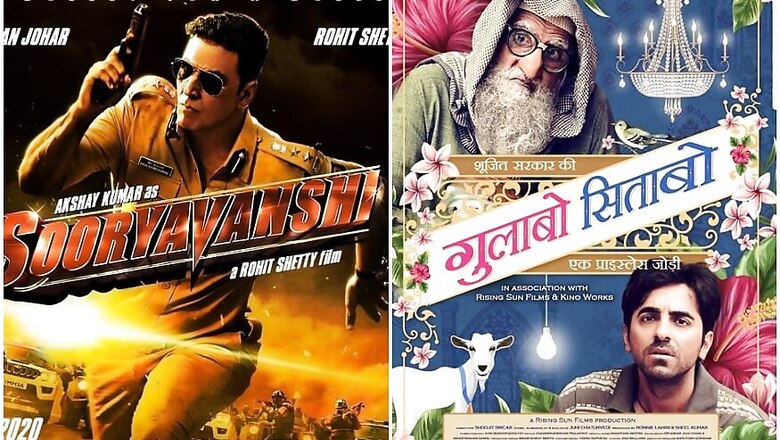
views
Movie theatres were among the first business establishments to shut down as India went under lockdown in view of the coronavirus outbreak. On May 4, the Multiplex Association of India (MAI) had appealed to studio partners, producers, artistes and content creators to support the cinema exhibition sector by holding their films and releasing them in theatres once they're opened again.
Exactly 10 days after MAI's appeal, the first major announcement of a movie going straight to digital was made.
Amazon Prime Video announced that the Amitabh Bachchan-Ayushmann Khurrana starrer Hindi film Gulabo Sitabo will globally premiere exclusively on the streaming service. The film was originally supposed to release in theatres on April 17. "This is the dawn of a new era for Indian entertainment," said the film's director Shoojit Sircar in a statement.
This dawn wasn't a welcome one for several stakeholders. Multiplex chain INOX released a statement expressing their "extreme displeasure and disappointment" over the move.
PVR Pictures CEO Kamal Gianchandani said, "We are disappointed with some of our producers deciding to go straight to the streaming platforms. We were hoping that the producers would accede to our request to hold back their film's release till cinemas reopen."
Not so long ago, filmmakers around the world were debating whether streaming services will eat up the business of theatres. The coronavirus outbreak has made that fear even more realistic. But is it really possible for streaming platforms to match the business, as well as the euphoria, of watching a movie in a theatre?
Stars are born in theatres, not on web platforms
The first category of films/stars that cannot afford to go straight to digital are the members of the Rs 100 to 300 crore clubs. Sooryavanshi and '83 were two big releases slated for the summer. Trade pundits and cinema chains are unanimous in saying that these films will have to wait till theatres open to release across India and overseas. Digital sales will not help recoup their Rs 100 crore plus budgets.
Film trade analyst Atul Mohan says, "For big budget movies it's practically impossible to recover the investment. All the A-listers - right from the three Khans to Akshay Kumar, Hrithik Roshan, Ajay Devgn, even Tiger Shroff and Varun Dhawan – star in big budget movies. They cannot recover the whole amount from the digital package only. The revenue model is roughly like this: They try to recover their making costs from the theater business in India, the P&A (publicity and advertising) from the overseas market and profit from the digital and satellite sales. You might save on P&A by releasing it on digital, but a producer won't be willing to let go of the Rs 100-150 crore business from theatres."
"For example, Sooryavanshi's making cost is Rs 125 crore. Looking at the last films of Akshay Kumar and Rohit Shetty, the film was expected to earn Rs 250 to 300 crore from the Indian theatrical business. It has Ajay Devgn and Ranveer Singh too, which increased expectations. There are four production houses involved – Reliance Entertainment, Rohit Shetty Picturez, Dharma Productions and Cape of Good Films. The film was expected to do Rs 100 crore minimum at the Indian box office. They would have earned another 30-50 crore from the overseas market. The digital and satellite rights were sold for around Rs 125 crore. An OTT platform cannot acquire a film like Sooryavanshi for Rs 200-225 crore," Atul explains.
So, if you want to watch an Akshay Kumar or Salman Khan entertainer, theatre is still your only option. "Once an A-lister like Akshay goes to digital, there will be no parameter to judge anyone's stardom. Stars are created from the cinema – the long queues, the mad rush – all that adds up to their stardom. The conversation about who is a bigger star will be eliminated," Atul says.
Read: Bollywood's 2020 Movie Calendar Goes for a Toss, Big Films Might not Release Till October-November
Which films are going straight to digital?
There is an upper-mid range of films, second to the biggies, that OTT platforms are picking up now. While large scale producers can afford to wait another six months, the lockdown is a grave problem for small-scale producers and independent filmmakers who seek loans from funding capitals.
Film trade analyst Girish Johar explains, "When a producer puts in his own money or takes loan against his assets, he has an obvious interest to pay to the bank. During this time, when the production has stalled, they still have to pay that interest amount. The government has given certain guidelines on a moratorium, but only for the time being, the interest hasn't been waived off. While big producers can bear this dent, smaller ones can't."
Demand for good content leading OTT to shop for films
The current situation is giving rise to several business models. Aparna Acharekar, Programming Head, ZEE5 India, agrees that the producers will sell their movies to OTT or wait for theatres depending on what suits them best. But the streaming services are looking for good content to meet consumer demands right now.
"Big and small releases jostle for space among themselves in theatres round the year. But now, there is a consumer demand with paucity of good content. So it's a good time to release movies on OTT. Our next movie release is Ghoomketu, which has Nawazuddin Siddiqui, Anurag Kashyap and even a cameo from Amitabh Bachchan. In a normal situation we'd have struggled to find space for it among so many films releasing in theatres. But now, this is going to be our big Eid release," Aparna says.
"The only one gaining in this entire situation is the consumer. The business which can adapt quickly to the consumer needs, ends up winning. People are willing to pay if you give them good content to watch on OTT,” she adds.
Will the audience go back to theatres?
As India enters phase 4 of lockdown after May 17, many restrictions might be eased, but it's not yet clear whether theatres will open. Cinema theatres, where several people sit close to each other in an air conditioned auditorium, are already figuring out new ways of operating to attract viewers again.
Tinku Singh, Group President & Chief Strategy Officer of SRS Cinemas, says, "We have been actively involved with government agencies and the MAI to figure out a way forward. Everybody wants to safeguard the interest of the viewers first. It will be a planned opening. The average occupancy in theatres is 36% in a week usually. Even if the weekend sees 100% occupancy and the weekdays see below 30%, the average is not more than 36%. So we can start with a target of 50% occupancy. Right now, most people are working from home, so they can come to watch movies on weekdays, too. We can reduce the number of shows, increase the gap in between so that people can maintain social distancing."
There are several other precautions that cinemas are planning in order to provide a safe viewing environment. With all the measures in place, Singh is hopeful that the audience is going to stay with the experiential cinema viewing option.
"Nothing can replace the experience of watching a film in theatres. We have seen the advent of the VCR, Blu-ray disc, home theatres over the years, but nothing can match the cinema experience," Singh says, adding that big budget films are buoyed by the earnings of theatres in order to produce more such films. "Even if an OTT platform pays Rs 100 crore for a movie, you cannot make a Baahubali with that money. So if these 100-500 crore clubs have to exist, they will have to come to theatres."
Follow @News18Movies for more



















Comments
0 comment